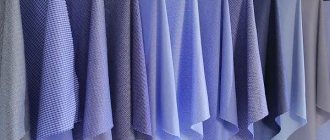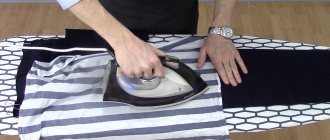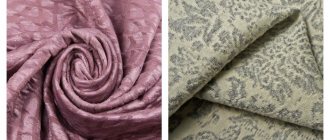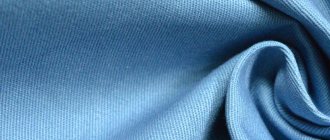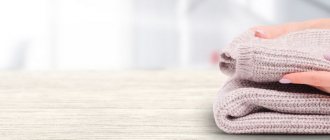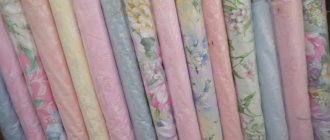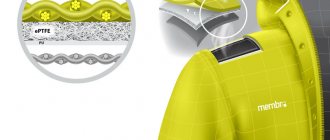Features and characteristics, description of Cheviot fabric
Cheviot made from sheep wool is distinguished by its thermal insulation properties and elasticity. The main feature is twill weave and short pile. The material is made from wool blend yarn and is characterized by a heterogeneous structure. Finished products give a respectable appearance, shine, clothes look smooth and pleasant to the touch. Find out about the characteristics and description of light fabric here.
The fabric is tough when in contact with skin.
What does it consist of, what does it look like
The name is associated with the sheep that live in the Cheviot Mountains of Scotland, whose wool is used to make yarn. Looks dense, heavy and tough.
Properties and quality, density
The demand for fabric is achieved due to its performance properties.
Properties:
- elasticity - achieved due to the quality of the yarn and weaving method;
- harshness;
- hygroscopicity;
- thermal insulation properties, protection from cold and wind;
- breathability, no greenhouse effect;
- durability, color and shape retention.
Surface density is 306-310 g/m2. When sewing and wearing products, certain features must be taken into account. Low resistance to abrasion in areas where product parts come into contact. Read about pleated fabric here.
Production technology and manufacturing
Semi-coarse wool was initially used as a raw material; today semi-woolen fibers are used for these purposes. Cotton threads are used to make the base. Sometimes wool fibers are combined with staple or cotton, which makes the fabric lighter.
Technologies allow the use of nettle fiber in production, the appearance and texture of classic fabric are preserved.
The twill weaving technique is used in production; there are specific stripes on the surface. This material will tell you about the types of linen fabric.
Smooth-haired material is available in dark colors without patterns. Clothes are produced in dark colors - black, blue, purple.
Advantages and disadvantages
Pure wool Cheviot has all the advantages of natural material, namely:
- strength;
- durability;
- good protection from cold and wind;
- breathability;
- hygroscopicity;
- elasticity.
However, at the same time, it is a rather stiff and heavy (more than 310 g/sq. meter) fabric that is difficult to iron and crumbles when cutting. In addition, it has low abrasion resistance and is damaged by moths.
Wool-blend textiles are softer and quite durable, but they wrinkle faster and lose color . Staple Cheviot is one of the most short-lived, but it is inexpensive.
Directions for using the canvas: [adrotate banner=»1"]
- Business and formal suits are made from woolen material and look very respectable.
- Wool-blend cheviot is widely used in uniforms for the army and for school.
- Inexpensive cotton and staple textiles are suitable for a summer casual wardrobe.
Varieties
In production, heterogeneous coarse yarn is traditionally used. It is suitable for sewing warm outerwear, sports suits, and hunting. This is how pure soft ladies' cheviot from pure yarn appeared; damask is widely used in sewing high-quality clothes. This article will tell you about the characteristics of the moleskin material.
The following types are distinguished:
- Worsted - twisted fine-fleece wool is used in its manufacture, the variety is characterized by elasticity, and its shine is considered a special feature.
- Cloth - consists of semi-fine short wool fibers, characterized by rigidity.
- Wool blend is a combination of wool and cotton, the material is widely used in tailoring suits.
- Staple - the texture is similar to wool, the properties are different, this variety was previously used in demand in the manufacture of uniforms and suits.
In connection with the development of technology and increased demand in manufacturing, raw materials from thin threads began to be used.
Origin and properties of Cheviot
For the first time, this fabric, which is classified as a variety of tweed, began to be produced around the 18th century, in the Cheviot Mountains on the border between England and Scotland, and for this they used the wool of local sheep, which were distinguished by a rather thin, albeit short, fleece. The fabric produced by the twill weave method was dense, durable and very warm, and its roughness and slight heterogeneity were compensated by its low price. Soon, Cheviot fabric began to be in great demand not only in England, but also in Europe, from where it came to Russia. It was originally used for warm outerwear, suits for hunting and active outdoor activities . The Victorian era contributed to the development of fashion trends in the English style. The demand for cheviot increased, which contributed to both the improvement of its manufacturing technology and a change in composition that made the material more accessible. For this fabric, they began to use any sheep's wool, including those with longer fibers, and also add cotton to it, which reduced the heat-protective qualities, but made the Cheviot softer and lighter.
Currently, Cheviot has several varieties:
- Worsted (an ancient name for ladies' wool), which is made from twisted fine wool. This fabric is of high quality, elasticity, softness, and has a surface with a characteristic shine.
- Cloth, for the production of which semi-fine short wool fibers are used. This is a dense and fairly stiff fabric with a small pile.
- Wool blend, made from mixed raw materials - wool with cotton and (or viscose). This is one of the most common suit fabrics.
- Staple and cotton cheviot have a texture corresponding to woolen fabric, but differ significantly from it in its properties. Until recently, it was widely used for the manufacture of uniforms and inexpensive suits, but has now practically fallen out of use.
The main characteristics of wool and wool blend cheviot are:
- strength;
- durability;
- high density (about 300 g/sq.m);
- elasticity;
- dimensional stability;
- surface with a characteristic diagonal pattern;
- good protection from cold and wind;
- no “thermos effect”;
- affordability.
It should be borne in mind that Cheviot is a rather heavy and rigid fabric. It crumbles when cutting, requires good sewing and ironing skills, and the most unpleasant thing is that it rubs off on the folds and is damaged by moths. However, these shortcomings are made up for by the elegance, durability and practicality of this vintage material, which is a worthy competitor to stylish tweed.
Care instructions
It is practical; frequent washing is not recommended. The material is not easily soiled and can be cleaned with a brush if necessary. Many products can be washed by hand or in a machine. It is recommended to dry clothes flat out on a horizontal surface, away from heating appliances and radiators. You should check the label before washing. Find out about the composition and description of Dior fabric at this link.
Some items cannot be washed; they may be sent to the dry cleaner. It allows you to get rid of tough stains.
Rules of care:
- washing - at 30 degrees or when setting the “Wool” mode;
- the use of gels or powders for woolen fabrics;
- prohibition on twisting when washing;
- ironing - through a damp iron on the “Wool” mode;
- airing clothes 2 times a year;
- storage in the closet on hangers, scarves and caps should be placed on shelves; cotton covers will help preserve things.
Susceptible to moths, it is recommended to place the tablets in a closet before storing.
History of Cheviot fabric
Cheviot fabric has a unique history, Cheviot is the border between England and Scotland. It was there that a breed of sheep was bred, whose wool became the basis for this fabric. This breed of sheep appeared in the 14th century, the village where these animals were bred was located from the Cheviot hills. Sheep wool was used to make various clothes. Subsequently, the fabric was improved, the technical characteristics and qualities of this material were improved. James Robson of Belfort brought large rams to cross with the local breed of sheep. Thus, in the 18th century, the production of tweed from Cheviot wool began in Great Britain. The material began to spread throughout the country and, after a while, throughout the world. At that time, this fabric was usually used for sewing sportswear. It was incredibly convenient, as well as practical and comfortable products that provided warmth and coziness.
Today, Cheviot is still relevant and is used for the production of outerwear. The exceptional qualities and properties of the material contribute to its demand and popularity. Items made from cheviot are stain-resistant, wear-resistant, and also look luxurious in many styles and perfectly retain their rich color and original appearance.
Types of tweed fabrics
There are many varieties of tweed, differing in color, pattern, thickness and other characteristics:
- Harris. Handcrafted in the Outer Hebrides (Scotland). The fabric weight is 0.5-0.8 kg/m. They do not dye finished yarn, but processed wool, which is then mixed in certain proportions.
- Bedford Court. The fabric is warm and belongs to the suit-coat group. Characterized by a wavy pattern and high density.
- Covercott. Translated from English it means “outerwear”. A single-color warp and two-color weft are intertwined, resulting in a small, motley ribbed pattern. The color is usually green or brown. Fabric for suiting and coats.
- Chambray. It is characterized by a blurred pattern, uneven outlines, and a bright color atypical for tweed.
- Hering. For its special weaving pattern, this variety is called herringbone or fish bone.
- Lace tweed. The warp consists of twisted threads, and the wefts are made of yarn, resulting in a lace pattern. The fabric is light and voluminous, usually used for sewing women's clothing.
- Houndstooth. Characterized by a complex, unusual pattern of abstract spots, reminiscent of a cage. The material is dense; coats and men's jackets are often made from it.
- Donegal. A thick, warm fabric made in the north of Ireland. Some tweed is produced by hand, the cost is high. This variety has thick, dense, rope-like threads, bright colors.
- Cheviot. Traditionally made from the wool of dark Cheviot sheep. The fabric is thin, but dense and fleecy. It is used to make women's and men's suits, coats, trousers, and uniforms for the military. The material is plain or with a geometric print.
Fact! The Soviet Union also had cheviot fabric, but unlike tweed it was cheap. It received its name because of its external resemblance to woolen material, although it was made from nettle fiber.
Tweed always has an ornament. This could be a heather effect - the main background with a small admixture of fibers of a different color. Among the ornaments, the most popular are Scottish check in various variations, strict herringbone, large window frame, shepherd's check, cloves, and barley ear.
Raw materials, production and types of fabric
In its classic version, suit cheviot is a natural fabric made 100% of wool. This material has a high price and belongs to the elite class. To reduce production costs and the cost of products, manufacturers began to add cotton, viscose, and synthetic threads. Additional fibers make the fabrics lighter while maintaining quality characteristics.
Based on its composition, matter is classified into several groups.
| View | Description |
| Worsted | Long threads are used in production. The result is a durable, elastic fabric with a minimum amount of lint. |
| Cloth | Short fibers of medium thickness are used. It is characterized by a fluffy surface and rigidity. |
| Wool blend | Combined wool and cotton version. Designed for sewing suits. |
| Staple | Similar in characteristics to the wool model. |
For information! Matter combines harmoniously with its “competitors”. Harmonizes with velvet, velor, suede, satin and other types of fabric.
Application area
Tweed is used to make a large number of products:
- Women's skirts, dresses, jackets, cardigans and suits.
- Classic business suits: three-piece and two-piece.
- Men's vests, trousers and jackets.
- Jackets, coats and ponchos.
- Breeches and shorts for winter.
- Berets, caps and hats.
- Shoes for sports.
- Accessories: bags, ties, scarves and belts.
- Riding suits.
Some manufacturers have described rules that require the mandatory wearing of suits made of tweed fabric. They go well with leather shoes and accessories.
